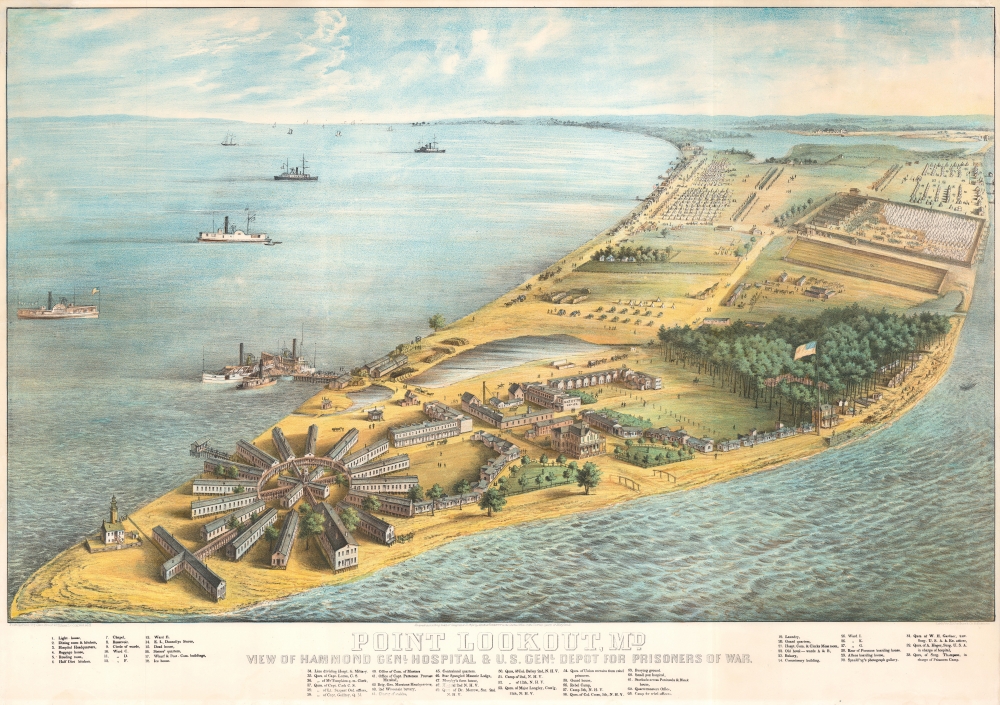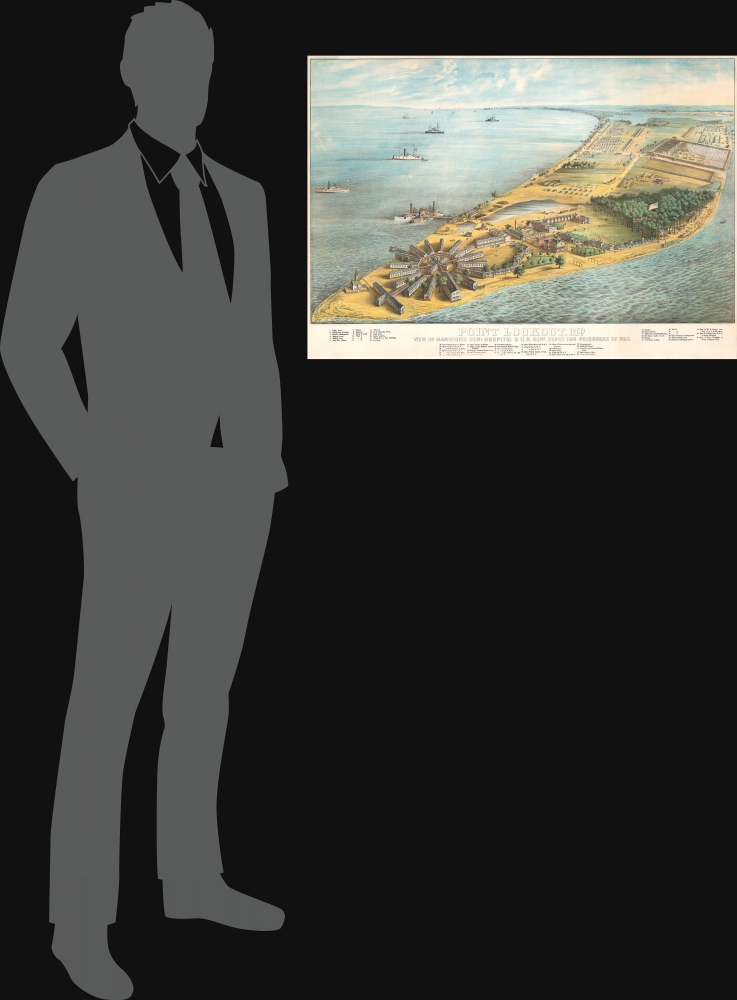This item has been sold, but you can get on the Waitlist to be notified if another example becomes available, or purchase a digital scan.
1864 Everett Bird's-Eye Civil War View of Point Lookout, Maryland
PointLookout-everett-1864
Title
1864 (dated) 21.5 x 30.5 in (54.61 x 77.47 cm)
Description
A Closer Look
Hammond Hospital appears in the foreground next to the lighthouse. The patient wards were arranged in a circle around the central buildings, resembling the spokes of a wheel. A chapel, 'half diet' kitchen, baggage room, and library/reading room occupied the center. The main or 'full diet' kitchen and dining room appear below and to the left of the 'wheel' (No. 2) and were connected to the hospital via a covered walkway. Sixty-three locations throughout are numerically identified (including the hospital wards and the other related buildings) and correspond with an index below the bottom border. Among these are the laundry, the bakery, camps of regiments based at Point Lookout, the quarters of the commanding officers of these units, and the Confederate prisoner of war camp. Perhaps the most jarring of the identified locations is the 'dead house' (morgue).A Short History of Point Lookout
Situated at the point where the Potomac River enters the Chesapeake Bay, the history of Point Lookout begins with the construction of a lighthouse in 1830. A seaside resort opened in 1859, the remains of which appear here. During the war, the hotel and its bungalows housed officers. The U.S. government rented the land from the resort owner in July 1862 and Hammond General Hospital received its first patients on August 17, 1862. The first Confederate prisoners were confined on the hospital grounds in early 1863 after being accused of aiding and abetting the Confederacy. The prisoner of war depot was established following the Battle of Gettysburg in July 1863 and was designed to house 10,000 prisoners. Initially, it covered 1,000 square feet but was soon expanded. 4,000 prisoners were at Point Lookout by September, but the prison reached its highest population in June 1864, around when this view was made, with some 20,000 prisoners. Living conditions at Point Lookout were as notorious as any other Civil War prisoner of war camp. Confederate prisoners were housed in tents deemed unfit for Union soldiers. Insufficient blankets and inadequate clothing compounded the problems. Many of the 4,000 prisoners who died at Point Lookout froze to death, but sanitary conditions were also abysmal, and disease also took a toll - especially due to the many nearby swamps. After the war, the owner attempted to reopen the hotel and bathing resort, but the horrific memories of the prison camp (the hospital was mostly forgotten) discouraged recreation. However, as time passed and memory faded, the hotel's popularity rebounded, until it burned around 1878. A Coast Guard station opened in 1908 and was repeatedly damaged by storms and ice. It ceased operation in 1937 and was abandoned in 1948. The state of Maryland bought nearly 500 acres of Point Lookout in 1962 and eventually built a museum. A national cemetery on the point is the final resting place of 3,389 Confederate dead.Chromolithography
Chromolithography, sometimes called oleography, is a color lithographic technique developed in the mid-19th century. The process involved using multiple lithographic stones, one for each color, to yield a rich composite effect. Oftentimes, the process would start with a black basecoat upon which subsequent colors were layered. Some chromolithographs used 30 or more separate lithographic stones to achieve the desired product. Chromolithograph color could also be effectively blended for even more dramatic results. The process became extremely popular in the late 19th and early 20th centuries when it emerged as the dominant method of color printing. The vivid color chromolithography produced made it exceptionally effective for advertising and propaganda imagery.Publication History and Census
This map was created and published by George Everett in 1864 and lithographed by Edward Sachse. Two states of this view exist. One includes an inset view of Headquarters of the General Commanding St. Mary's District in the upper left corner. The other (of which the presently offered example is representative) does not include the inset. The publication information is identical on both, as is the index below the view, making it extremely difficult to know which state came first. We know of a single cataloged example of the present edition, part of the collection of the H. Furlong Baldwin Library at the Maryland Center for History and Culture. We note one other instance when the present state has appeared on the private market.CartographerS
George Everett (1833 - XXXX) was an American military officer. Everett originally enlisted in Company C, 148th New York Volunteers but then was mustered out of the New York Volunteers to fill a vacancy as an officer in the 38th Regiment U.S. Colored Infantry and joined the unit on April 21, 1864, in Norfolk, Virginia, and was commissioned as a 1st Lieutenant. For some time the 38th United States Colored Troops were stationed at Point Lookout, Maryland, where Everett published the Hammond Gazette, a weekly newspaper published for patients at the Hammond General Hospital, a Civil War era hospital the treated both Union wounded and Confederate prisoners of war. Everett was promoted to Captain September 21, 1865, and transferred with the regiment to Brazos Santiago, Texas, and served as Captain of Company D, 38th Regiment, U.S. Colored Infantry. Everett was discharged on January 25, 1867. More by this mapmaker...
Edward Sachse (1804 - 1873) was a German American artist, lithographer, and publisher. Born in Görlitz, Germany, Sachse operated a small lithographic firm and publishing house in Germany before immigrating to the United States in 1848. He settled in Baltimore, where he worked for E. Weber and Company briefly before opening his own firm, E. Sachse and Company, around 1850. During the 1850s, 1860s, and early 1870s, Sachse developed a reputation as the main lithographer of the Maryland - Washington D.C. area. One of his most recognizable accomplishments was the role he played in documenting the construction of the U.S. Capitol, along with other major building projects in Washington. He also created a massive twelve-sheet aerial view of Baltimore (which took three years and several artists to produce) and a four-sheet view of Syracuse. During the American Civil War, Sachse produced a series of lithographs of military campsites, hospitals, and barracks in Baltimore and Washington, D.C. Sachse sold these views at the bargain price of 25 cents to soldiers as souvenirs and often created multiple views of the same encampment when new regiments moved in, and the scenery, fortifications, and tents changed. Soldiers bought the prints and often mailed them home, sometimes with notes marking their specific tent. Sachse had a close working relationship with Charles Magnus (1826 - 1900), who published and sold many of Sachse's works. Sachse's firm also published advertising posters, book illustrations, labels, and business cards. Learn More...




